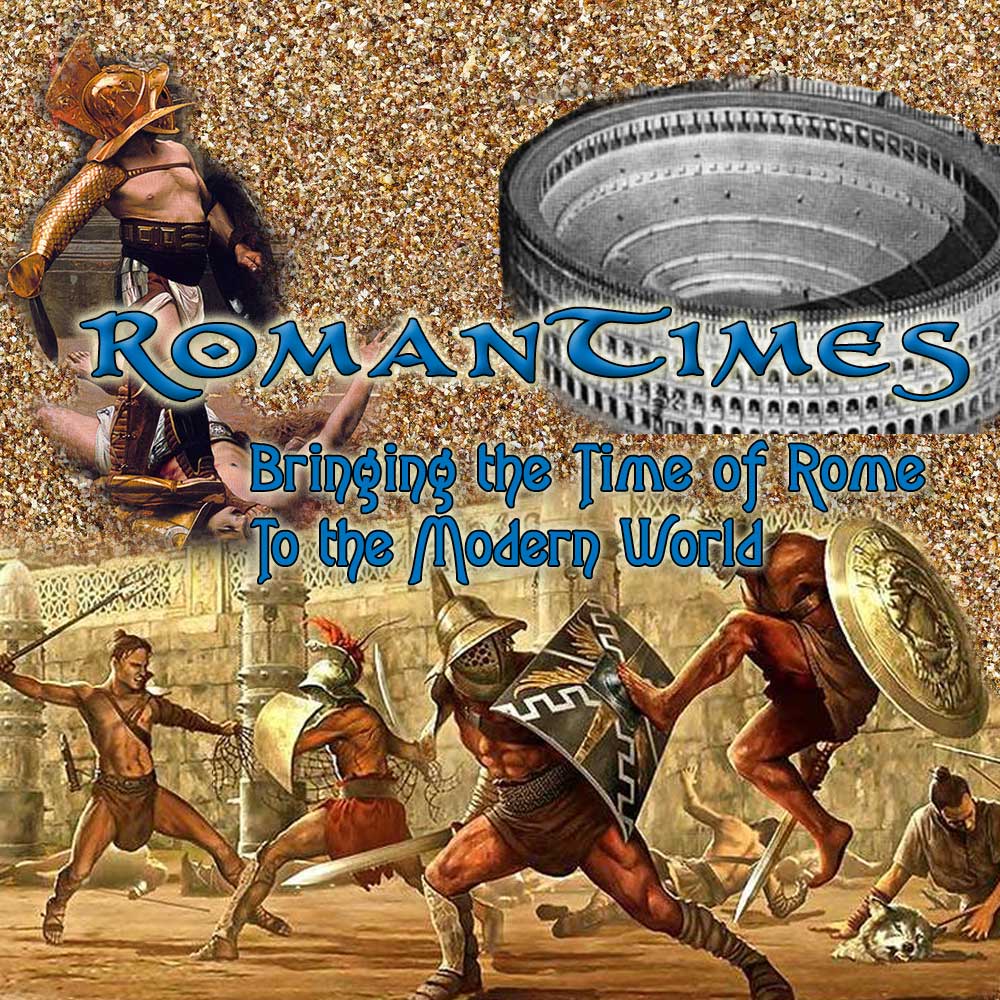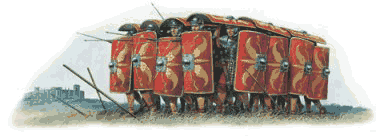Styles of Gladiators and Types of Combat
Samnite
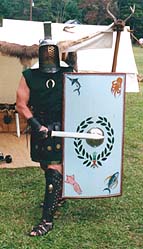
"Samnium": One of the first types of Gladiator, they took their name from the Samnites, which were among the earliest enemies of the emerging Roman dominance of northern Italy. They generally utilized heavy armor with a visored helmet, large scutum (shield), wrist guards and a ocrea (greave) on the lower left leg. Samnites fought with the Gladius (short sword) giving rise to the general term "Gladiator" being applied to most of those who fought in the Arena.
Hoplomachus
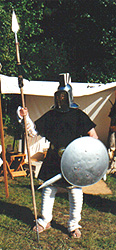
(Heavy Armor) This style of fighter was very similar to the Samnite, but they were more heavily armored with a fully protected right arm, large shield, more massive helmet and more leg protection. It appears that the Hoplomachus was a later style of the Samnite and they also fought with the gladius. During the Republic "heavy" fighters were termed Samnites and in the Empire Period they became known as Hoplomachus.
Thracian
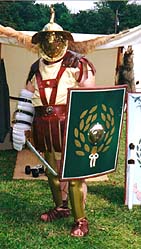
(Light and Fast) These fighters depended on being more lightly armored and therefore more agile and faster in evading their adversary. Thracians utilized an unusual curved style sword called a "Sica" and carried a small round shield called a "parma", along with large greaves on both legs which extended above the knees. They had no chest armor; but did have full right arm protection and a crested helmet. Some of the helmet crests were shaped like a griffin, alluding to a mythological bird of prey.
Mirmillo/Murmillo
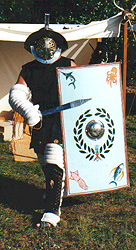
(Fish Man) With just right arm protection and a non-visored helmet, these gladiators were relatively unprotected; but were still considered "heavy" fighters due to the large and heavy shield they carried. They fought with a gladius-style sword. The term of Mirmillo/Murmillo or "Fish Man" may have come from the fact that they were generally paired with the Retarius (or "Net Fighter") who would attempt to catch his Fish Man opponent in his net and then stab him with his trident spear.
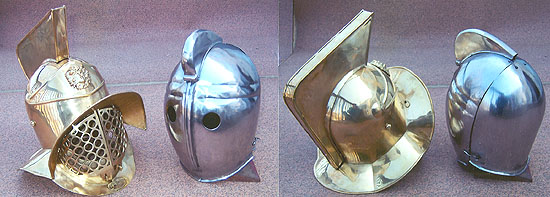 Above, a "Mirmillo / Murmillo" or "Fish Man" style helmet, topped with a fish-like dorsal fin, on the left and a "Secutor" or "Chaser" style on the right. Note the smooth contours of the Secutor helmet that minimized its being snagged by the Retiarius' net, with whom the Secutor was usually paired. Also, the eye holes of the Secutor helmet were sized an spaced to make it difficult for the 3-pronged trident of the Retiarius to penetrate it. The Mirmillo was also often paired with the Retiarius; but his helmet with some sharp angles and corners would offer a better target for the Retiarius' net.
Above, a "Mirmillo / Murmillo" or "Fish Man" style helmet, topped with a fish-like dorsal fin, on the left and a "Secutor" or "Chaser" style on the right. Note the smooth contours of the Secutor helmet that minimized its being snagged by the Retiarius' net, with whom the Secutor was usually paired. Also, the eye holes of the Secutor helmet were sized an spaced to make it difficult for the 3-pronged trident of the Retiarius to penetrate it. The Mirmillo was also often paired with the Retiarius; but his helmet with some sharp angles and corners would offer a better target for the Retiarius' net.
Secutor
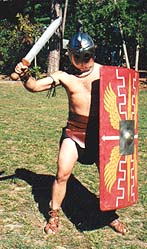
(Chaser) The technique of this fighter was to chase his opponent around the field of battle and exhaust him out for the kill. He wore a rounded crested helmet with small round eye holes. Although limiting vision, the small eye holes made it nearly impossible for the Retriarius' trident tines to penetrate to the Secutor's eyes. The smooth shape of the helmet, without any projections, was less likely to be come ensnared in the net thrown by the Retiarius; with whom he was generally paired for a fight. The secutor had full right arm protection and wore an Ocrea (greave) on the lower left leg. He also carried a large rectangular scutum (shield).
Retiarius
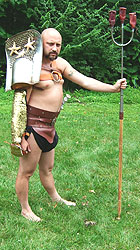
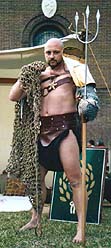
(Net and Trident) These fighters fought by attempting to snare and entangle their opponent in a net that he would cast like a fisherman and then would stab him with the three-pronged "trident" spear he carried. The net had weights attached to the edges that would cause the net to flare-out when thrown. The net also had a tether cord attached tpo it, so that the Retiarius could draw it back if it failed to snare his adversary. The Retiarius wore no helmet or body armor; other than a manica (arm guard) on his arm and a Galerus (large flared shoulder piece).
Above, a Retiarius shown with Trident, Net and Galerus. Note the squamata (fish scale) Manica (arm guard), decorated Galerus shoulder shield and safety covers on Trident points in right hand photo.Gladiatrix
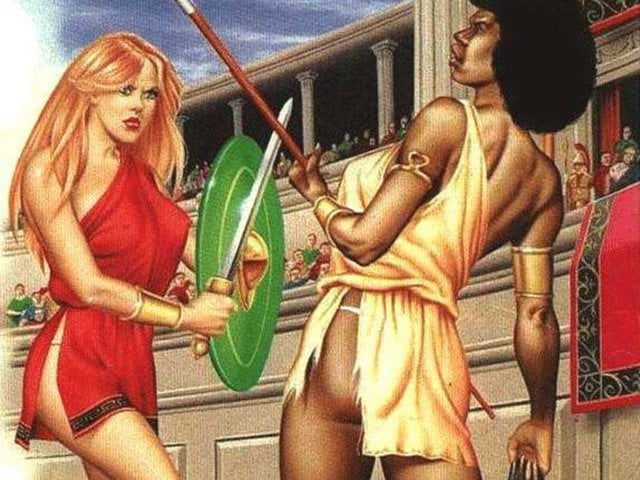
(Female Gladiator) These were especially popular with the crowds. The frequency with which female gladiators appeared in the arena is disputed. The first instance in which they were explicitly reported was during Nero/'s reign, by Cassius Dio. The next recorded appearances occurred during Domitian/'s reign, in which there were two reports, from Cassius Dio and Seutonius. Finally, during the inauguration of the Coliseum, Cassius Dio and Martial describe female venatores, or animal hunters. Apart from these references, there are two physical records of gladiatrix participation. An inscription in Ostia in the mid second century records the local magistrate, Hostillianus, boasting that he is the first since the founding of Rome to provide female gladiators. In addition, the previously mentioned Missio at Halicarnassus provides evidence of another fight outside of Rome. These six references are the only certified references we have.
/When they did fight, the Gladiatrix would have fought in two primary capacities. There are a number of sources which indicate that they would have fought as venatores, or hunters of beasts. Martial compares their fights against beasts in Titus/'s games to Hercules fighting the Nemean Lion. Also, they would have fought against other women. Gladiators were usually pitted against fighters of similar skill and capacity. There is some evidence that they fought against dwarves. However, Brunet, referencing a number of ancient historians, indicates this this was unlikely. Gladiatrices were looked upon with more serious admiration, and would not have been pitted against dwarfs for comic relief. At times they would fight in group fights with men, however during these fights they would often be in chariots in order to counteract the physical disparities.
More Types of Gladiators

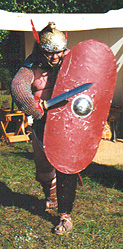
Dimacheri | Provocateur | Hermes | Psychopompo "Mercury">
Dimacheri (Two Handed) Gladiators who fought with two swords. This term can also be applied to those who fought from horseback.
Eques/ Equites (Equestrian) Those who fought "mounted", that is from horseback using various weapons.
Laqueatores (Noose-Snare) A variation of the "Retiarius" who attempted to use a spear and noose or lasso to snare their opponents.
Essedarius/Essedarii (Chariot Warriors) Combatants who rode chariots during their engagements.
Ordinarii (Ordinary) were gladiators who fought in pairs or in the ordinary manner.
Andabatae (Blinded) These fighters wore helmets with no eye apertures, thus they fought "blind" which was especially exciting to the spectators.
Sagittarius An animal fighter armed with bow and arrow.
Meridiani (Median) These were lightly armored fighters who fought in the middle of the day after the morning "Beastiary" engagements with wild animals had taken place.
Catervarii (Crowd) A term applied when the combatants fought in a melee as a group or mob, instead of in pairs.
Venatio/Bestiarium A show that often featured trained animals performing tricks, wild animal hunts, animals fighting each other or animals killing condemned criminals. Generally staged as a mid-day event prior to the main gladiatorial "munus gladiatorium" engagements.
Munus A favor or gift of public entertainment. "Munus-Gladiatorium" a free or provided gift of a gladiatorial combat exhibition to the public by the leaders of Rome.
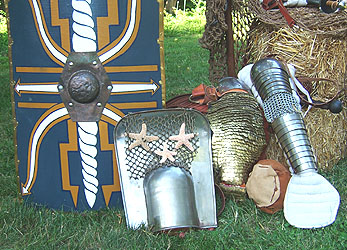
Array of Gladiatorial Equipment, Left to Right: Large scutum shield as used by the so-called "Heavy" fighters, Samnite, Hoplomachus, Thracian, Murmillo | A Galerus shoulder & neck shield decorated with starfish and net, as used by the Retiarius | Squamata (fish scale) style Manica arm guard. Segmentata (articulated plate) style Manica arm guard, with padding.

Left to Right: Undecorated medium size Parma style round shield | Shoulder and upper chest armor (behind shield). - Secutor style helmet with small round eye holes | Leg Greave -guard | Retiarius Trident and Net, with round hilt sword in front | Twin-bladed "Scissorarius" sword, resting against a Thracian scutum-shield, with Thracian helmet and referee's staff above | Round Parma shield with Medusa image and two swords, a bottle and other small items above.
Some Details
A gladiator would generally have his left leg extended forward when in his battle stance, hence he would only wear protection on his left leg and ankle. The Mirmillo and Retiarius generally wore no leg protection due to their fighting strategies. The Thracian, and at times, other gladiator styles as well, would wear greaves on both legs, with the left hand greave sometimes being more ubstantial than the one on the right leg.
Too Valuable
Despite what Hollywood would have us believe, good and/or popular gladiators were seldom deliberately killed. They were far too valuable to their owners and promoters; as much time, expense and effort had been expended in their training and preparation. [exp w/ George and Rob comments]
Thumbs Up or Down
The Emperor's "thumbs-up" to "spare" or "thumbs-down" to "kill" is another typical mis-interpretation from Hollywood. In actuality, the proper sign is thought to have been pollicis-deflectere (turned thumb) with the thumb turned sideways across or towards the chest, which indicated thrust downward into the neck or upper back. The thumb held down upon the fist, pollicis-demissus is thought to have meant mitto/missus "let go of" or "to spare" by indicating that the victorious gladiator should retire his weapon to the ground and withdraw from the engagement.
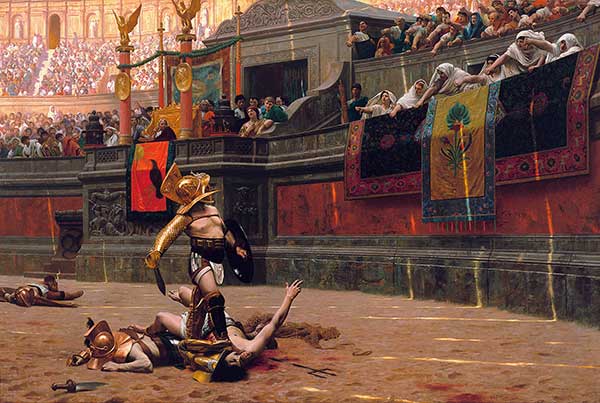 The origin of the "up-thumb" and "down-thumb" is believed to have come fro flawed translations of Greek and Latin texts and the 1872 painting "Pollice Verso (Thumbs Down) by the French painter Jean Leon Gerome, shown above. This famous rendering shows a victorious Mermillo styled gladiator, with his foot on his fallen opponent's throat, looking up to see the fatal gesture of "thumbs down" being given by the the crowd surrounding the Emperor's Box, that dooms his enemy to death. Hollywood then spread this mis-interpretation in its many "sword and sandal" epics.
The origin of the "up-thumb" and "down-thumb" is believed to have come fro flawed translations of Greek and Latin texts and the 1872 painting "Pollice Verso (Thumbs Down) by the French painter Jean Leon Gerome, shown above. This famous rendering shows a victorious Mermillo styled gladiator, with his foot on his fallen opponent's throat, looking up to see the fatal gesture of "thumbs down" being given by the the crowd surrounding the Emperor's Box, that dooms his enemy to death. Hollywood then spread this mis-interpretation in its many "sword and sandal" epics.

